
Veliki Tabor Castle. (661k)
There is lots of history in Croatia. Like in Slovenia, but unlike in the other Balkan countries, many of the castles in Croatia have been beautifully restored. There are lots of old churches that are nicely restored.
All pictures are © Dr. Günther Eichhorn, unless otherwise noted.
Dvor Veliki Tabor (Veliki Tabor Castle) is a castle and museum in northwest Croatia, dating from the middle of 15th century. The castle's present appearance dates back to the 16th century.
Most of the castle was built by the Hungarian noble family of Ráttkay, in whose ownership it remained until 1793.
It is the best-preserved medieval castle in Croatia. It houses a small museum of artifacts of daily life.



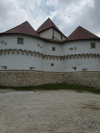
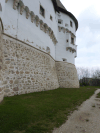
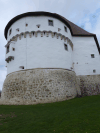

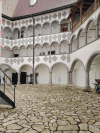
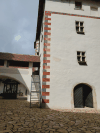
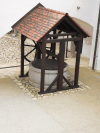


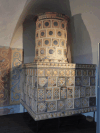
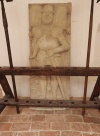
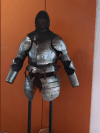





Staro Selo (Old Village) is an Open Air Museum. It contains 40 preserved residential, commercial, and ancillary buildings, including the birth place of Marshal Tito.









From the Ston entry in Wikipedia:
Because of its geopolitical and strategic position, Ston has had a rich history since antiquity. Located at the gates of the peninsula, surrounded by three seas, protected by four hills, rich in fresh water and saltwater, fertile plains, it has been an important political, cultural and ecclesiastical center. It is possible that there was a bishop in Ston as early as at the end of the 7th century or the beginning of the 8th century.
Initially it was an Illyrian settlement until the Romans established their own colony there in 167 BCE.
In 533, at Salona, a diocese was established in Sarsenterum for the Zahumlje or Hum area, which belonged to the church in Ston (Pardui). Later Sarsenterum was destroyed (most likely at the time of Avar's campaign). Since Ston was not reached by Avar's, it was spared and became the seat of the local župa. As the secular and ecclesial powers grew, it is assumed that after the disappearance of Sarsenterum, Ston became the ecclesiastical center. We see the diocese first mentioned in 877 as the institution from an older times, and the bishop is listed as a suffragan of the Split metropolis. By setting up a metropolis in Dubrovnik, Ston became a suffragan of Dubrovnik.
Upon the arrival of the South Slavs, the area of the Neretva (from the northern Herzegovina mountains to Rijeka Dubrovačka) was organized as the principality of Zahumlje - same as Neretva, Primorje and Zahulje, which also belonged to Ston with Rat (Peljesac) and Mljet. Local rulers acknowledged the supremacy of Byzantine Empire. After Mihajlo Višević, who acknowledged the authority of Bulgarian Simeon, Zahumlje was ruled over by different dynasties. Around 950, it was briefly ruled by duke Časlav. At the end of the 10th century, Samuilo was the Lord of Zahumlje, and the dukedom belonged to king Ivan Vladimir. In 1168, the dukedom and Zahumlje were conquered by Stefan Nemanja. Thirty years later, Zahumlje was invaded by Andrija, the Duke of Croatia and Dalmatia. In 1254, Béla IV of Hungary conquered Bosnia and Zahumlje. From 1304, Zahumlje was ruled by Mladen II Šubić, then again for a short period by Serbian župan, and then became part of the medieval Bosnian state, acquired by Stjepan Kotromanić in 1325, until it was finally sold to Dubrovnik.
The original old town was demolished in the earthquake of 1252. With the arrival of the Republic, a new city was built on today's location. When renovations were made at the church of St. Michael at the top of the hill, fragments of Roman decorative plaster, Roman tombstones and antique ceramics were found, confirming this assumption. According to some sources, Ston experienced a destructive civil war in 1250, and in these conflicts the city suffered a great deal of destruction.
The turbulent times at the beginning of the 14th century spread across the entire country of Zahumlje. The usurpation by the Branivojević brothers, forced the people of Dubrovnik to fight them in 1326 with the help of Stjepan Kotromanić. That year, Dubrovnik occupied Ston. The Dubrovnik people immediately began to build and establish a new Ston, to defend the Pelješac peninsula and protect the slaves from which they had earned big revenue. Since the conflict between the Bosnian Ban and the king of Zahumlje, the Dubrovniks purchased Pelješac with Ston from both rulers in 1333.
In 1333, Dubrovnik started with the planned construction of the fortresses of Ston (Veliki Ston) and Little Ston (Mali Ston) at the present site. The cladding between the two towns along their entire length were made of large walls that were supposed to defend the Dubrovnik estate - Pelješac. This entire fortification complex, which is unique to Europe was built over a short period of time.
The downfall of the Republic of Dubrovnik took place due to the sudden and often incomprehensible operations in the 19th century. The city walls of Little Ston were demolished to suppress malaria. The monumental stone fortification complex of Ston suddenly collapsed in preparation for the official visit by Austrian Emperor Franz Joseph - the stones became a quarry for nearby new outcrops and foundations. The restoration of the stone monuments and the reconstruction of the fortifications and the tower resumed only after 1945, however they were again damaged in the Croatian War of Independence (1991-1995), followed by the devastating earthquake of 1996. Recently, thanks to the Society of Friends of the Dubrovnik Walls, the stone forts and towers are being reconstructed, so that the monumental stonewall complex now begins to live again in its old dignity.










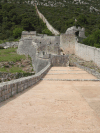






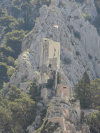
This page contains 47 pictures

Main page for Hrvatska (Croatia)
Page last updated on Thu Jun 16 11:42:08 2022 (Mountain Standard Time)
Page last updated on Wed Apr 24 14:15:23 2024 (Mountain Standard Time)
History in Croatia on geichhorn.com